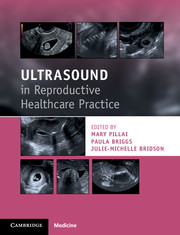Book contents
- Ultrasound in Reproductive Healthcare Practice
- Ultrasound in Reproductive Healthcare Practice
- Copyright page
- Contents
- Contributors
- Foreword
- Acknowledgments
- 1 A Short History of Ultrasound in Gynaecology
- 2 Use of the Ultrasound System
- 3 Communication Skills in Ultrasound Assessment
- 4 Ultrasound of Pelvic Anatomy Scanning Techniques and ‘Normal’ Findings
- 5 Contrast Sonohysterography
- 6 Ultrasound of Abnormal Pelvic Anatomy: Benign Pathology
- 7 Pregnancy Ultrasound for SRH Work
- 8 Ultrasound Assessment of a Potential Ectopic Pregnancy
- 9 Ultrasound Imaging of Progestogen-Only Subdermal Contraceptive Implants*
- 10 Ultrasound Imaging in Relation to Intrauterine Contraception*
- 11 The Role of Ultrasound Scanning in the Investigation and Management of Subfertility
- 12 Polycystic Ovaries, Polycystic Ovary Syndrome and the Role of Ultrasound in Relation to This Condition
- 13 Ultrasound Imaging of Women with Abnormal Uterine Bleeding (AUB)
- 14 The Use of Ultrasound in the Perimenopausal Patient
- 15 Recognition of Possible Gynaecological Cancer
- 16 Quality in SRH Ultrasound Service Provision
- 17 Annotation, Archiving, Reporting and Audit
- Glossary of Abbreviations and Terms
- Index
- References
10 - Ultrasound Imaging in Relation to Intrauterine Contraception*
Published online by Cambridge University Press: 21 December 2017
- Ultrasound in Reproductive Healthcare Practice
- Ultrasound in Reproductive Healthcare Practice
- Copyright page
- Contents
- Contributors
- Foreword
- Acknowledgments
- 1 A Short History of Ultrasound in Gynaecology
- 2 Use of the Ultrasound System
- 3 Communication Skills in Ultrasound Assessment
- 4 Ultrasound of Pelvic Anatomy Scanning Techniques and ‘Normal’ Findings
- 5 Contrast Sonohysterography
- 6 Ultrasound of Abnormal Pelvic Anatomy: Benign Pathology
- 7 Pregnancy Ultrasound for SRH Work
- 8 Ultrasound Assessment of a Potential Ectopic Pregnancy
- 9 Ultrasound Imaging of Progestogen-Only Subdermal Contraceptive Implants*
- 10 Ultrasound Imaging in Relation to Intrauterine Contraception*
- 11 The Role of Ultrasound Scanning in the Investigation and Management of Subfertility
- 12 Polycystic Ovaries, Polycystic Ovary Syndrome and the Role of Ultrasound in Relation to This Condition
- 13 Ultrasound Imaging of Women with Abnormal Uterine Bleeding (AUB)
- 14 The Use of Ultrasound in the Perimenopausal Patient
- 15 Recognition of Possible Gynaecological Cancer
- 16 Quality in SRH Ultrasound Service Provision
- 17 Annotation, Archiving, Reporting and Audit
- Glossary of Abbreviations and Terms
- Index
- References
- Type
- Chapter
- Information
- Ultrasound in Reproductive Healthcare Practice , pp. 163 - 181Publisher: Cambridge University PressPrint publication year: 2018
References
- 1
- Cited by



